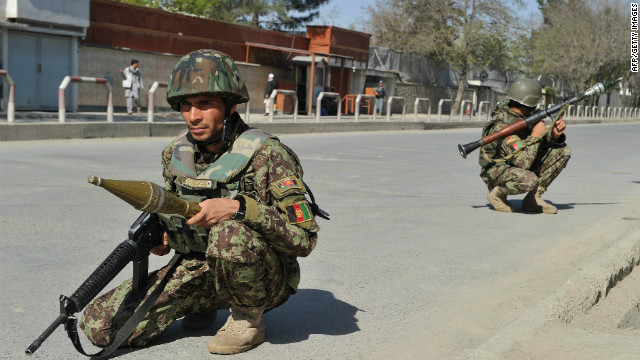M WAQAR..... "A man's ethical behavior should be based effectually on sympathy, education, and social ties; no religious basis is necessary.Man would indeed be in a poor way if he had to be restrained by fear of punishment and hope of reward after death." --Albert Einstein !!! NEWS,ARTICLES,EDITORIALS,MUSIC... Ze chi pe mayeen yum da agha pukhtunistan de.....(Liberal,Progressive,Secular World.)''Secularism is not against religion; it is the message of humanity.'' تل ده وی پثتونستآن
Wednesday, May 16, 2012
Ready or not, Afghan security transfer accelerating
NATO forces are here until 2014,
but each day the demands on them lessen as Afghan forces take on more responsibility.
Earlier this week, the latest tranche of the security transfer process was announced. A third swathe of Afghanistan will see Afghan national forces take the lead on security, with the NATO-led International Security Assistance Force (ISAF) scaled back into to a supporting role only.
Most taxpayers funding the decade of war in Afghanistan won't have heard of many of the regions affected, but this tranche is particularly significant because three quarters of the country will now be under the control of Afghan security forces.
On Sunday, NATO Secretary General Anders Fogh Rasmussen said once the move is implemented, "transition will have begun in every one of the 34 provinces of Afghanistan, including every provincial capital."But some of the areas involved in this latest handover are surprising.
The most striking is Kandahar City, the former Taliban stronghold that has embodied the brutal struggle of the Afghan conflict for ISAF forces, as progress has been neither universal nor permanent.
There are other small surprises: Half the districts in Nurestan -- a huge mountainous region that straddles the border with Pakistan and has become as close to an insurgent safe haven as Afghanistan has -- were handed over, as were a third of the districts in Paktika, another border enclave for insurgents.
Uruzgan, a volatile region in the center of the country where Australian Prime Minister Julia Gillard said progress has been so pronounced her soldiers can start to come home early, was also handed over.
Afghan officials are in favor of an early transition while there are enough ISAF troops around to step in if the insurgency proves a match for the Afghan military. It's probable they will, as the Taliban have given the NATO-led military machine a run for its money.
Meanwhile, the fight for localized power may overcome any sentiments of nationalism that would enable Afghan soldiers to be comparatively welcome in villages and towns across the country. The risk here is front-loaded, which is as much a reflection of the pressing ISAF timetable as it is of progress in security.
Within a few months -- when this third tranche has passed -- only a quarter of Afghans will have security provided by ISAF. The timetable for withdrawal, although pinned to the distant marker of the end of 2014, is speeding up as the calls for an end to this costly and unpopular war get louder, from Canberra to Washington.
The key fact for the months ahead, and for the NATO summit in Chicago later this month, is that the United States predicts its forces will be in a non-combat role by mid-2013. That means they'll be off the battlefield about 18 months earlier than the end of the NATO mission.
This is a big deal for one simple reason: ISAF anticipates at the end of this year having about 68,000 American troops to play with, and thousands more allies. Next year the numbers will come down further -- at a "steady pace" for the Americans, as President Obama promised. But being in a non-combat role is, you might argue, something you don't need 68,000-plus soldiers for. There are units out there now who already believe much of their job involves packing up and handing over, that their fight is pretty much over already.
The real question still to be answered though is how much does -- or can -- the Taliban want to push ISAF and the Afghan forces this summer? Do they have the unified command or muscle, or have talks about peace talks shattered their unity of purpose? For now we just don't know.
However, the weekend assassination of a senior Afghan official involved in setting up peace talks with the Taliban, as well as the deaths of two ISAF troops in an IED attack, suggests the security situation remains far from stable.
United Nations figures on security incidents judged 2011 the most violent year on record, and ISAF's own count of violence -- attacks against them or their partners -- showed that while incidents dropped nationwide, they rose to record levels in the key areas of the south and east.
It remains unclear whether this summer will be as violent, or, if the Taliban continues its campaign of roadside bombs, assassinations and high-profile attacks on NATO targets in Kabul, whether Afghans will feel safer regardless of what the numbers say.
There have also been some curious casualty figures among international forces in the first three months of this year. According to the U.S. Army and ISAF, insurgents did not cause almost two thirds of American deaths from January to March. They were a result of accidents such as helicopter crashes, natural causes, or the new scourge of the campaign: "Green on blue shootings," when men in Afghan uniform shoot ISAF personnel.
Subscribe to:
Post Comments (Atom)


No comments:
Post a Comment